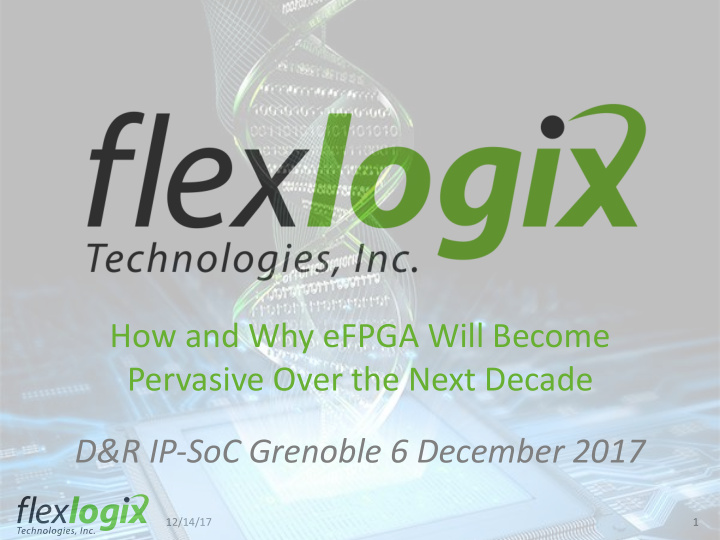



How and Why eFPGA Will Become Pervasive Over the Next Decade D&R IP-SoC Grenoble 6 December 2017 12/14/17 1
Chip Design Costs Escalating With Each Node Mask costs: ~$1M for 40nm, ~$2M for 28nm, ~$5M for 16/14nm! Engineering cost/complexity shifting full custom to high level design 12/14/17 2
Fewer Tapeouts On Advanced Nodes 40+28+16/14nm: ~800 designs in 2016, ~1,300 in 2020 12/14/17 3
Chips Must Do More • The Semiconductor TAM continues to grow • The breadth of applications is increasing • So fewer tape-outs means chips must do more by being programmable • Processors are good and have become pervasive • But FPGA provides a different type of programmability that can sometimes do what processors can’t, e.g. § Parallelism § State machines § Low power without memory references 12/14/17 4
eFPGA Make ICs Flexible • Reconfigure RTL in your SoC/MCU anytime § Keep up with changing algorithms, industry standards, and customer requests § One chip can serve multiple applications § Longer chip life, higher ROI • Embedded FPGA IP can be used anywhere in a chip Embedded FPGA 12/14/17 5
Why Will eFPGA Succeed This Time? • eFPGA has been tried many times in the last 20 years § Actel § IBM/Xilinx § LSI Logic § Leopard Logic § And more • Found one product in last 20 years using eFPGA: Stretch • Not sure why they failed § probably because they didn’t meet the needs of the market 12/14/17 6
What Customers Need From eFPGA IP • Available in the target process node and metal stack • Density similar to FPGA chips in terms of LUTs/mm 2 • Proven in silicon • Available in the size needed (# of LUTs) • Available with DSP/MAC and/or RAM if required • High I/O count for connecting to wide, fast buses • Software to program with high speed & utilization 12/14/17 7
eFPGA ≠ FPGA • FPGAs are designed every few years for each new process node and are optimized with full-custom logic and typically use maximum metal stacks • eFPGA based on an FPGA may § Not be in the process variant the customer needs and be slow/expensive to port due to full-custom logic § Not be compatible with the customer’s metal stack § Not be scalable in size to meet the customers’ needs 12/14/17 8
New Technology Adoption Curve eFPGA today is just starting adoption ARM took 5 years to get 5 customers Rambus took 5 years to get Nintendo-64 eFPGA is at the start of a similar “S Curve” 12/14/17 9
eFPGA Now Available on Mainstream Nodes 16nm 12/14/17 10
Now Multiple eFPGA Suppliers • Flex Logix • Achronix • Adicsys • Efinix • Menta • QuickLogic 12/14/17 11
Multiple eFPGA Users Announced in 2017 • Four announced eFPGA users (all using Flex Logix) § DARPA for any US Government application in 16nm § Harvard University Deep Learning chip in 16nm § Sandia 180nm captive port for multiple products § SiFive customizable 28nm SoC and 180nm MCU platform chips • More have prototypes and are in design 12/14/17 12
Wide Range of Applications for eFPGA Microcontroller/IoT Networking • Reconfigurable accelerators/DSP • Reconfigurable protocols • Reconfigurable Serial I/O • Programmable parsers • Customer specific RTL • Programmable NIC • Battery life extension Data Center SOCs & ASICs • Processor+FPGA • Reconfigurable accelerators/DSP • Accelerators • Deep Learning • Programmable switch • Algorithm iteration in real time • Programmable NIC Wireless Base Station Aerospace/Defense • Reconfigurable DFE • Integration to reduce power, size, (digital front end) weight • Manufacturing in US/Europe • Rad-Hard eFPGA 12/14/17 13
Aerospace/Defense Electronics • Reconfigurability is critical for aerospace/defense systems given their long design cycles and long deployments • eFPGA provides § Lower power § Smaller volume § Lower weight § US Fabrication § Even Rad-Hard for space applications • DARPA believes embedded FPGA is strategic for defense ICs • Sandia using eFPGA for multiple products in their 180nm fab 12/14/17 14
Reconfigurable Accelerator SOC/MCU ARM MPU EFLX Reconfigurable EFLX ROM SRAM FLASH Accelerator System Bus AHB-Lite Bus AHB To APB Bridge GPIO EFLX PMU Buffers Counters IOs eFPGA accelerates AES/SHA/JPEG/FFT 30-140x faster than ARM 15 12/14/17 15
eFPGA for SiFive SoC Platform Chips • Freedom U500 • Customizable 28nm SoC • eFPGA: reconfigurable accelerator and up to 64 GPIO • Platform chip ~$750K for customized U500 with in design with eFPGA for ~100 package prototypes eFPGA 12/14/17 16
eFPGA for SiFive MCU Platform Chips • Freedom U500 • Customizable 180 MCU • eFPGA: reconfigurable accelerator and up to ~32 GPIO • Will port T180 on demand ~$100K for customized U500 with eFPGA for ~100 package prototypes 12/14/17 17
Reconfigurable Cloud: Data Centers • Reconfigure hardware protocols § Networking § Storage § Security • FPGA Acceleration § Deep Learning § AI 12/14/17 18
Deep Learning / AI • Harvard 16nm Deep Learning Chip with eFPGA in evaluation • Professor Gu-Yeon Wei: § “Huge opportunity for reconfigurable logic in deep learning. Algorithms for deep learning change and improve quickly: with eFPGA we can iterate in real-time” 12/14/17 19
Very Large eFPGA Available • EFLX200K in validation • ~183K LUT4 • 560 22x22 MACs • Multiple SRAM blocks, PLL & PVT monitors for testing >1GHz to validate all specs over temperature and voltage 12/14/17 20
eFPGA Will Become Pervasive eFPGA in 5-10 years eFPGA in 3-5 years We have talked to 100s of customers >95% say “eFPGA is great, we will use it” • >90% want to wait for others to go first • When current customers go to production, adoption will take off • 12/14/17 21
www.flex-logix.com 12/14/17 22
Recommend
More recommend